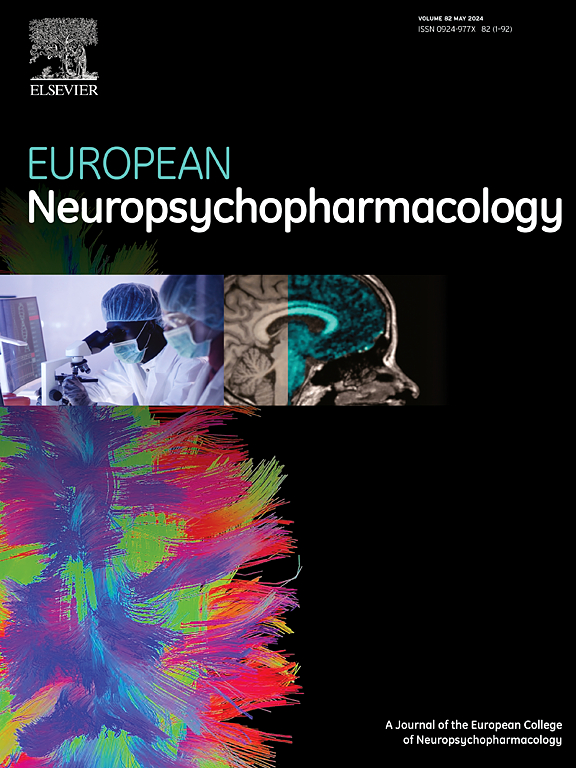Predicting 10-year risk of chronic kidney disease in lithium-treated patients with bipolar disorder: A risk model development and internal cross-validation study
IF 6.1
2区 医学
Q1 CLINICAL NEUROLOGY
引用次数: 0
Abstract
Lithium is a first-line maintenance treatment for bipolar-disorder (BD) but has increased risk for chronic-kidney-disease (CKD). There is a paucity of research on risk-model development predicting CKD during/following lithium treatment, and none was conducted in Asian regions. This study aimed to derive and validate 10-year risk prediction model for CKD-stage 3 in first-diagnosed BD patients receiving ≥ 1 prescription of lithium during 2002–2018 in Hong-Kong, using electronic-medical-record database of public-healthcare services. Literature-informed predictor selection included demographics, physical comorbidities, mean lithium serum-levels and non-lithium psychotropic use. The risk-equation was developed using Least-Absolute-Shrinkage-and-Selection-Operator (LASSO) Cox-proportional hazards regression model with 4-fold internal cross-validation over 1,000 iterations. We identified 2,258 lithium-treated BD patients, with CKD incidence of 12.6 per 1000 person-years (95 %CI=11.1–14.4) over a median follow-up of 7.7 years (interquartile range=3.7–12.3). Our results showed that older age at BD-diagnosis, male sex, physical comorbidities, higher mean lithium serum-level, fewer antipsychotic and mood-stabilizing anticonvulsant use, and greater antidepressant exposure were independent risk factors predicting CKD, with an event-per-variable ratio of 25.2. The 10-year risk prediction model had satisfactory area-under-the-curve (AUC) (0.74 [95 %CI=0.66–0.83]), with good calibration (calibration slope=0.88 [95 %CI=0.61–1.15]; observed/expected risk ratio=1.14 [95 %CI=0.86–1.42]), and discrimination performances (Harrell's C-index=0.75 [95 %CI=0.68–0.82]; Royston and Sauerbrei's D statistic=1.45 [95 %CI=0.99–1.92]). In conclusion, this CKD risk-model for lithium-treated BD patients demonstrated satisfactory prediction performance in a predominantly-Chinese population. Further research including external validation is needed to verify model performance to facilitate implementation of this CKD risk prediction tool for individualized clinical decision-making and outcomes in real-world practice.
预测锂治疗双相情感障碍患者10年慢性肾脏疾病风险:风险模型开发和内部交叉验证研究
锂是双相情感障碍(BD)的一线维持治疗药物,但会增加慢性肾脏疾病(CKD)的风险。关于锂治疗期间/治疗后预测慢性肾脏病的风险模型开发的研究很少,而且没有一项研究是在亚洲地区进行的。本研究旨在利用公共医疗保健服务的电子病历数据库,对2002-2018年期间在香港接受过≥1次锂处方治疗的初诊BD患者进行10年CKD第3期风险预测模型的推导和验证。根据文献资料选择的预测因子包括人口统计学特征、身体合并症、平均锂血清水平和非锂类精神药物的使用。风险方程采用最小绝对值-收缩-选择操作器(LASSO)Cox比例危害回归模型,并经过1000次迭代的4倍内部交叉验证。我们确定了 2,258 名接受过锂治疗的 BD 患者,在 7.7 年(四分位间范围=3.7-12.3)的中位随访期间,CKD 发病率为每 1000 人年 12.6 例(95 %CI=11.1-14.4)。我们的研究结果表明,BD 诊断年龄较大、男性、身体合并症、平均锂血清水平较高、较少使用抗精神病药和稳定情绪抗惊厥药、较多抗抑郁药暴露是预测 CKD 的独立风险因素,事件与变量的比值为 25.2。10 年风险预测模型的曲线下面积(AUC)(0.74 [95 %CI=0.66-0.83] )令人满意,校准效果良好(校准斜率=0.88 [95 %CI=0.61-1.15];观察/预期风险比=1.14 [95 %CI=0.86-1.42] ),并且具有良好的区分性能(Harrell 的 C 指数=0.75 [95 %CI=0.68-0.82] ;Royston 和 Sauerbrei 的 D 统计量=1.45 [95 %CI=0.99-1.92] )。总之,这一针对锂治疗 BD 患者的 CKD 风险模型在以中国人为主的人群中表现出了令人满意的预测性能。还需要进一步的研究,包括外部验证,以验证模型的性能,从而促进这一CKD风险预测工具在实际临床实践中用于个体化临床决策和结果。
本文章由计算机程序翻译,如有差异,请以英文原文为准。
求助全文
约1分钟内获得全文
求助全文
来源期刊

European Neuropsychopharmacology
医学-精神病学
CiteScore
10.30
自引率
5.40%
发文量
730
审稿时长
41 days
期刊介绍:
European Neuropsychopharmacology is the official publication of the European College of Neuropsychopharmacology (ECNP). In accordance with the mission of the College, the journal focuses on clinical and basic science contributions that advance our understanding of brain function and human behaviour and enable translation into improved treatments and enhanced public health impact in psychiatry. Recent years have been characterized by exciting advances in basic knowledge and available experimental techniques in neuroscience and genomics. However, clinical translation of these findings has not been as rapid. The journal aims to narrow this gap by promoting findings that are expected to have a major impact on both our understanding of the biological bases of mental disorders and the development and improvement of treatments, ideally paving the way for prevention and recovery.
 求助内容:
求助内容: 应助结果提醒方式:
应助结果提醒方式:


